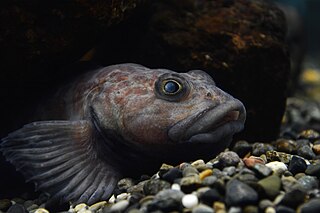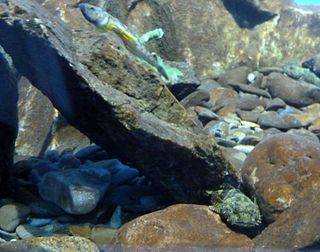
Lake Baikal is a rift lake that is the deepest lake in the world. It is situated in southern Siberia, Russia between the federal subjects of Irkutsk Oblast to the northwest and the Republic of Buryatia to the southeast.

The Baikal seal, also known as Lake Baikal seal or Baikal nerpa, is a species of earless seal endemic to Lake Baikal in Siberia, Russia. Like the Caspian seal, it is related to the Arctic ringed seal. The Baikal seal is one of the smallest true seals and the only exclusively freshwater pinniped species. A subpopulation of inland harbour seals living in the Hudson Bay region of Quebec, Canada,, as well as the Saimaa ringed seal and the Ladoga seal, are also found in fresh water, but these seals are part of species that also have marine populations.

The Abyssocottinae are a subfamily of ray-finned fishes in the family Cottidae, the sculpins. They are known commonly as the deep-water sculpins. The entire subfamily is endemic to Lake Baikal in Siberia.

Comephorus, known as the golomyankas or Baikal oilfish, are a genus comprising two species of peculiar, sculpin fishes endemic to Lake Baikal in Russia. Comephorus is the only genus in the subfamily Comephorinae. Golomyankas are pelagic fishes and the main food source for the Baikal seal.
The short-headed sculpin ray-finned fish belonging to the family Cottidae, the typical sculpins. This species is endemic to Lake Baikal in Russia. It lives at depths of from 400 to 1,600 metres, and is not longer than 12.2 centimetres (4.8 in) TL. This species is the only known member of its genus.
Procottus is a genus of ray-finned fish belonging to the family Cottidae, the typical sculpins. These fishes are endemic to Lake Baikal in Russia.

Cottocomephorus is a genus of freshwater ray-finned fishes belonging to the family Cottidae, the typical sculpins. This genus is endemic to Lake Baikal and its surrounding tributaries in Russia. They have relatively large pectoral fins and reach up to 22 cm in total length. They are an important food for the Baikal seal, during the winter second only to the golomyankas.
Kessler's sculpin is a species of Baikal sculpin, a freshwater fish native to Russia and Mongolia where it occurs in Lake Baikal and surrounding lakes as well as the Selenga, Angara and Bain Gol rivers. It is the only member of its genus. In Lake Baikal it occurs on sandy, rocky-sandy or sandy-muddy bottoms, ranging from relatively shallow water to depths of 70 m (230 ft). In rivers they mainly occur in slow-flowing channels and floodplains.
The stone sculpin is a species of cottoid fish endemic to Russia, where it is found in Lake Baikal and surrounding tributaries as well as the Gramninskie Lakes, Lake Verkhnaya Agata and the Enisei River and various lakes in Tuva. This species is the only recognized member of its genus.

Abyssocottus gibbosus is a species of ray-finned fish belonging to the family Cottidae, the typical sculpins. These sculpins are endemic to Lake Baikal in Russia. It dwells at a depth range of 400–1600 metres. Males can reach a maximum total length of 14 centimetres.
Asprocottus abyssalisis a species of ray-finned fish belonging to the family Cottidae, the typical sculpins. These sculpins are endemic to Lake Baikal in Russia. It was described by Dmitrii Nikolaevich Taliev in 1955, originally as a subspecies of Asprocottus herzensteini. It is a freshwater fish which is endemic to Lake Baikal, Russia. It is known to dwell at a depth range of 150–1400 metres.
Asprocottus intermedius is a species of ray-finned fish belonging to the family Cottidae, the typical sculpins. It was described by Dmitrii Nikolaevich Taliev in 1955, originally as a subspecies of Asprocottus herzensteini. It is a freshwater fish which is endemic to Lake Baikal, Russia. It is known to dwell at a depth range of 200–800 metres.
Asprocottus minor is a species of ray-finned fish belonging to the family Cottidae, the typical sculpins. It was described by Valentina Grigorievna Sideleva in 2001, originally as a subspecies of Asprocottus korjakovi. It is a freshwater fish which is endemic to Lake Baikal, Russia.
Cyphocottus eurystomus is a species of ray-finned fish belonging to the family Cottidae, the typical sculpins. These sculpins are endemic to Lake Baikal in Russia. It was described by Dmitrii Nikolaevich Taliev in 1955, originally as a subspecies of Asprocottus megalops. It is a freshwater fish which is endemic to Lake Baikal, Russia. It is known to dwell at a depth range of 50–600 metres.
Limnocottus pallidus is a species of ray-finned fish belonging to the family Cottidae, the typical sculpins. This species is endemic to Lake Baikal in Russia. It dwells at a depth range of 150–1000 metres. Males can reach a total length of 13.1 centimetres and females 14.6 cm. L. pallidus can weigh up to 16 grams, and live up to 12 years.
Neocottus thermalis is a species of ray-finned fish belonging to the family Cottidae, the typical sculpins. It was described by Valentina Grigorievna Sideleva in 2002. It is a freshwater, deep water-dwelling fish which is endemic to Lake Baikal, in Russia. It is known to dwell at a depth range of 430 to 480 metres.
Procottus gurwicii, the dwarf sculpin, is a species of freshwater fish endemic to Lake Baikal in southern Siberia, Russia. It was discovered in 1946 when a single male specimen was found in the coastal waters of the lake, at a depth of about 93 metres. The specimen measured a total length of 6.2 centimetres.

Procottus major is a species of ray-finned fish belonging to the family Cottidae, the typical sculpins. This species is endemic to Lake Baikal in Siberia. It was originally described as a subspecies of the similar but smaller red sculpin. P. major can be found at depths of up to 900 m (3,000 ft), especially on a muddy or rocky-mud bottom. In the spring and summer it typically occurs deeper than 100 m (330 ft), and in the fall and winter from 30 to 200 m (98–656 ft). It can reach a length of 30 cm (12 in), but is usually 18–22 cm (7.1–8.7 in). It feeds on smaller animals, especially gammarids, and breeding occurs in the winter at depths of 60–140 m (200–460 ft). This species is fished and its young are an important food source for other fish.
The bighead sculpin is a species of sculpin fish that is endemic to the Lake Baikal watershed in Siberia, Russia. It typically lives on rocky bottoms, often in places with sponges, at depths of 5 to 70 m (16–230 ft), but can occur as deep as 120 m (390 ft). Its colour varies from grayish to brownish or greenish depending on the bottom type. It can reach up to 22 cm (8.7 in) in length, but most are 13–16 cm (5.1–6.3 in). It feeds on a wide range of smaller animals such as young fish, insect larvae, amphipods, molluscs and oligochaetes. Breeding is in the spring where the female lays 618 to 1622 eggs, which are guarded by the male.

The Baikal yellowfin, also known as the yellow-finned sculpin or yellow-wing sculpin, is a species of freshwater ray-finned fish belonging to the family Cottidae, the typical sculpins. This species is endemic to Lake Baikal and its tributaries in Siberia, Russia. It is most common in the southern part of the lake and lives from near the shore to a depth of 300 m (980 ft).







